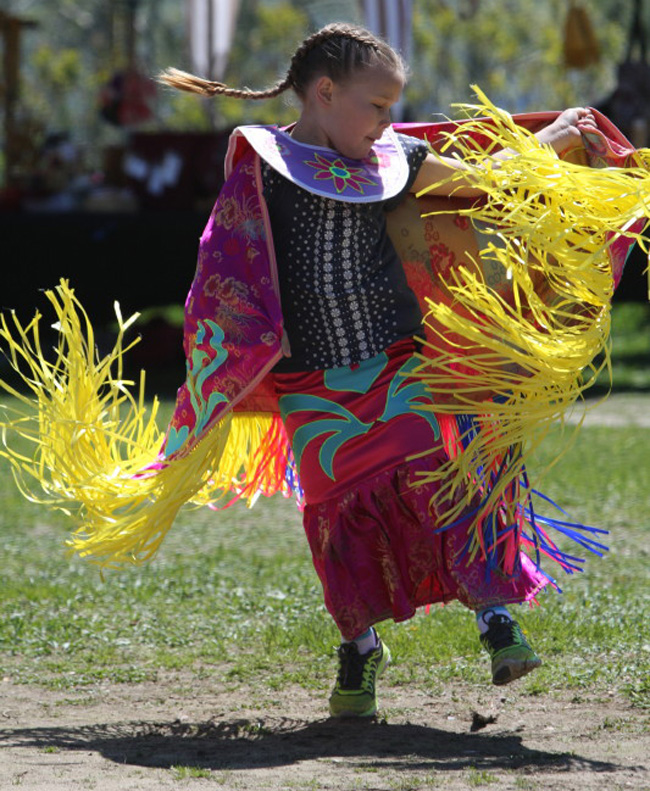‘Honouring One Another’ – 6th Annual CIES Pow Wow

By Sharon Weatherall
BEAUSOLEIL FIRST NATION – “This Pow Wow is a celebration of who we are,” said Deina Bomberry – a teacher from Wasauksing School.
“We have been given a good life and we dance to celebrate. Teaching culture and tradition gives the children a stronger idea of the identity of Anishinabek people.”
Bomberry was from one of four visiting schools that attended the 6th Annual Christian Island Elementary (CIES) School Pow Wow on Wednesday May 20, which hosted about 400 people. Schools at the event included Wasauksing from Parry Island, St. Antoine Daniel from Victoria Harbour, Oakley Park from Barrie and Barrie North Collegiate.
The Pow Wow opened with Grand Entry led by CIES principal Angela Johnson and the Beausoleil First Nation (BFN) Councillor Andrew Copegog, who were carrying sacred Eagle Staffs. The Eagle staff is carried by one who has earned the right in battle (war veterans) or one who has earned the honour in the eyes of the Pow Wow organizers, or by the owner of the Eagle Staff.
Following in the Grand Entry were representative flag carriers from BFN Emergency Service and Fire Department, local Veterans and the Canadian Flag as well as head youth dancers Gavin King and Larissa Kidd, with head Male and Female Dancers Clayton King and Kayla Duquette, respectively. Emcee of the event this year was Lee Benson from Rama.
A Pow Wow is a ceremony that sets a person dreaming of the old days, the old ways and looking ahead to the future. It is a time for people to share culture and heritage through drumming, singing, dancing, feasting and laughter. Christian Island students and community members contribute to the CIES Pow Wow hosting vendor tents, food and craft stations around the school yard for people to enjoy
In her welcome speech Principal Angela Johnson said the CIES Pow Wow has grown in leaps and bounds since the very first year.
“Many schools want to come and attend, so many that we have to turn some away. I would like to thank the students who organize and prepare for this event each year – they start in the fall to prepare,” said Johnson.
Throughout the day there was dancing and singing to demonstrate special dances as well as Intertribal dances in which everyone is invited to participate. The drum keeper keeps and protects the drum and singers. Songs are usually ancient ones that were handed down through generations and include The Flag Song, The Veteran’s Song, Intertribal and Honour Songs. The dancers are wearing colourful regalia. Each dancer’s regalia is considered to be very personal with sentimental or spiritual attachment. The four styles of dancers include traditional, fancy, jingle or grass dancer.
“The story of the Jingle Dress begins with Maggie White, a member of the Whitefish Bay First Nation located on the shores of Lake of the Woods in Northwestern Ontario. The dress and the dance originated from a dream. As the story goes a young girl was sick and gave no signs of recovering. Her distraught father offered his tobacco and prayed for the Creator’s assistance,” explained Emcee Lee Benson.
“Assistance came by way of a dream in which the father was shown how to create this dress and instructed about a dance that would accompany the dress. Upon waking he set about making the dress and put it on his daughter so that she would dance as he had been instructed to show her. In spite of her illness she was able to somehow dance and as the dance progressed she became stronger and relieved of her illness. The girl Maggie White, went on to live a long and fulfilling life sharing teachings associated with the jingle dress.”
Benson said a sacred obligation is carried by women who wear this dress as the Jingle Dress Dance is considered to be a healing dance. They are often called upon to dance for sick or injured community members or to help families who are grieving. The spiritual power of the dress is said to originate as an energy which emanates from the sound of the metal cones that sing out to the spirits as the dancer moves in time with the drum.
The dominant legend of the grass dance is that a Northern Plains boy born handicapped yet yearning to dance, was told by his medicine man to seek inspiration in the prairie. Upon doing so the boy had a vision of himself dancing in the style of the swaying grasses. He returned to his village, shared the vision and eventually was given back the use of his legs through the first ever grass dance. Another origin which is generally cited involves scouts stomping on the grasses to flatten them when a new area was being settled to create a venue for a tribal meeting or secure an arena for a ceremony.
Grade 8 student Erdanya Anderson from Oakley Park School in Barrie was excited to attend the CIES Pow Wow.
“It is great to see the different cultures. We actually had a Pow Wow at our school a couple of weeks ago where we have a group of First Nation students,” said Anderson who is part of a mixed leadership team that is working together to create a cultural gathering at Oakley School.
“My favourite part of today was the dancing – it’s quite something else.
Dancing shows who they are and everyone has the right to be proud of their culture and tradition. Overall it was fantastic and a really eye opening experience.”
The CIES Pow Wow ended at around 1:30 with closing ceremonies, followed by a feast in the school gym featuring traditional native food.


